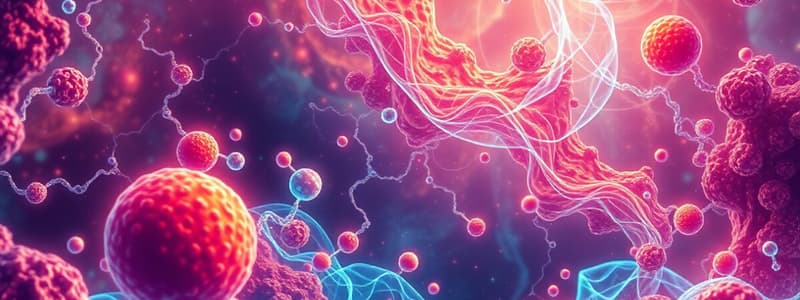Podcast
Questions and Answers
Which of the following ketone bodies is not metabolized and is instead a side product?
Which of the following ketone bodies is not metabolized and is instead a side product?
- 3-hydroxybutyrate
- Acetoacetate
- Acetyl CoA
- Acetone (correct)
What triggers the synthesis of ketone bodies in the liver?
What triggers the synthesis of ketone bodies in the liver?
- An excess of glucose availability
- An increase in fatty acid mobilization (correct)
- A surplus of lipoproteins
- A decrease in glucose levels
Which of the following tissues can utilize ketone bodies for energy during fasting?
Which of the following tissues can utilize ketone bodies for energy during fasting?
- Liver cells
- Brain cells (correct)
- Epithelial cells
- Red blood cells
What is a consequence of disorders in fatty acid oxidation?
What is a consequence of disorders in fatty acid oxidation?
During ketogenesis, what happens to excess acetyl CoA when the Krebs cycle is diminished?
During ketogenesis, what happens to excess acetyl CoA when the Krebs cycle is diminished?
Which of the following statements is true about ketolysis?
Which of the following statements is true about ketolysis?
Which statement regarding the liver's ability to utilize ketone bodies is correct?
Which statement regarding the liver's ability to utilize ketone bodies is correct?
What effect do ketone bodies have on glucose utilization during fasting?
What effect do ketone bodies have on glucose utilization during fasting?
What is the primary cause of ketonemia in individuals with uncontrolled type 1 diabetes mellitus?
What is the primary cause of ketonemia in individuals with uncontrolled type 1 diabetes mellitus?
What symptom is commonly associated with diabetic ketoacidosis due to elevated ketone bodies?
What symptom is commonly associated with diabetic ketoacidosis due to elevated ketone bodies?
How does the presence of ketone bodies in the blood affect blood pH?
How does the presence of ketone bodies in the blood affect blood pH?
What leads to the dehydration of the body in cases of diabetic ketoacidosis?
What leads to the dehydration of the body in cases of diabetic ketoacidosis?
Which of the following conditions can also cause ketoacidosis, apart from uncontrolled diabetes?
Which of the following conditions can also cause ketoacidosis, apart from uncontrolled diabetes?
Flashcards
Ketoacidosis
Ketoacidosis
A condition where the body produces more ketone bodies than it can use, leading to an excess in both the blood (ketonemia) and urine (ketonuria).
Fruity odor on breath
Fruity odor on breath
A sweet, fruity smell on the breath, often a symptom of ketoacidosis, caused by the increased production of acetone.
Acidemia
Acidemia
The condition of having a low blood pH due to excess ketone bodies in the bloodstream.
Dehydration in ketoacidosis
Dehydration in ketoacidosis
Signup and view all the flashcards
Ketoacidosis (in diabetes)
Ketoacidosis (in diabetes)
Signup and view all the flashcards
What are ketone bodies?
What are ketone bodies?
Signup and view all the flashcards
What is Ketogenesis?
What is Ketogenesis?
Signup and view all the flashcards
What is Ketolysis?
What is Ketolysis?
Signup and view all the flashcards
Why does the liver produce ketone bodies during fasting?
Why does the liver produce ketone bodies during fasting?
Signup and view all the flashcards
What is the advantage of ketone bodies as an energy source?
What is the advantage of ketone bodies as an energy source?
Signup and view all the flashcards
How are ketone bodies related to diabetic patients?
How are ketone bodies related to diabetic patients?
Signup and view all the flashcards
What are the consequences of disorders of fatty acid oxidation?
What are the consequences of disorders of fatty acid oxidation?
Signup and view all the flashcards
Can the brain use ketone bodies for energy?
Can the brain use ketone bodies for energy?
Signup and view all the flashcards
Study Notes
Biochemistry and Nutrition (BAN 203) - Lecture 28: Ketone Bodies Metabolism
- Ketone bodies are acetoacetate, 3-hydroxybutyrate, and acetone (a non-metabolized byproduct).
- Ketone bodies are important energy sources for peripheral tissues. They are water-soluble, so they don't require lipoproteins or albumin to be transported.
- This is particularly important during prolonged fasting.
- Ketone bodies are produced in the liver when the amount of acetyl CoA exceeds the liver's oxidative capacity.
- Ketone bodies are used in proportion to their blood concentration by extrahepatic tissues like skeletal and cardiac muscle, and renal cortex.
- The brain can use ketone bodies for energy if blood levels rise sufficiently, which saves glucose.
- Disorders of fatty acid oxidation present with hypoketosis (due to decreased acetyl CoA availability) and hypoglycemia (due to increased reliance on glucose).
- During fasting, the liver is flooded with fatty acids from adipose tissue, leading to high hepatic acetyl CoA.
- Some acetyl CoA enters the Krebs cycle, but excess acetyl CoA is diverted into ketone body synthesis.
- Ketone bodies provide energy for the heart, skeletal muscle, kidney, and brain.
- Ketolysis (breakdown) of ketone bodies in extrahepatic tissues, including the brain, but excludes cells lacking mitochondria (like red blood cells).
- Liver cannot use ketone bodies for fuel because it lacks thiophorase.
- Excessive ketone body production (hyperketonemia) is a symptom of uncontrolled type 1 diabetes mellitus. High levels of ketones can also be seen in prolonged fasting.
- Excessive ketone body formation leads to ketonemia (high in blood) and ketonuria (high in urine).
- In severe diabetic ketosis, urine excretion can reach 5000mg/24 hrs and blood concentration can rise to 90 mg/dl. Normal levels are less than 3 mg/dl.
- A fruity odor on the breath is a symptom of diabetic ketoacidosis due to increased acetone production.
- Ketone bodies are acidic; their buildup results in acidemia (acidosis). Each ketone body releases a proton, lowering the body's pH.
- Excretion of glucose and ketone bodies in the urine causes dehydration.
- Increased H+ ions in reduced plasma volume cause severe acidosis (ketoacidosis).
Specific Objectives
- Students should understand ketone bodies, their origin, and formation.
- Students should differentiate between ketogenesis and ketolysis.
- Students should understand the relationship between ketone bodies and diabetes.
Reference Material
- Lippincott's Illustrated Reviews Biochemistry (5th or 6th edition) by Champe, Harvey, and Ferrier (2005)
Studying That Suits You
Use AI to generate personalized quizzes and flashcards to suit your learning preferences.



